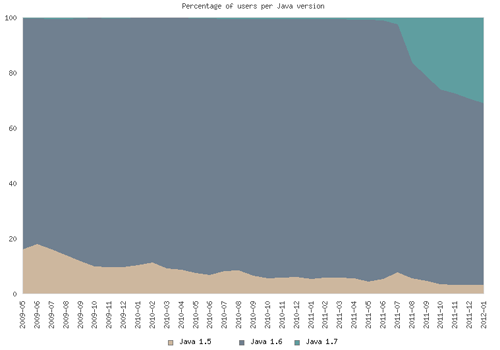This is possibly a case of
Warning: Dates in your diary might be closer than they appear.
Oracle just announced that the “EOL date” for Java 6 has been shifted back. From July to November. While it is undoubtedly a relief for many that Java 6 has an additional four month of life left (for many of those few at least, who are aware of this at all) it still means one thing: End of life for Java 6 is in November! 2012!
Yes, that means this year. You didn’t know that, did you?
Now, this doesn’t mean that Java 6 will topple over dead on 1st November. It will, of course, continue to work for some time. But it does mean that Oracle will stop issuing updates and releases after that date for free. (You can still buy support from Oracle, but that will really only be an option for large businesses.)
So, while this will come as somewhat of a shock to some, it this too soon? That depends how you view it. Java 7 has been in full public release since July 2011, so it will be well over a year of the next major version being on the market by the time Java 6 bites the dust. Time enough for most to update?
Let’s look at where people really are. Here is the distribution of Java versions of users of BlueJ:

BlueJ users by Java version
This shows us: Java 7 is currently used by just under a third of BlueJ users. (For Greenfoot, this number is a little lower than this.) About 3% still use Java 5.
So, while Java 7 has been out for a while, Java 6 is still by far the dominant version. The reality is: Many universities and schools update only infrequently, and updates to Java 7 haven’t happened yet in many places.
We would hope that this changes over summer: many educational institutions upgrade their lab software over the norther hemisphere summer break, so that might give a good boost to Java 7 before November.
But will most of the Java 6 installations disappear by then? Most likely not. Especially on Mac OS, it’s difficult: Java 7 isn’t even in public release for that platform yet.
So, if you’re responsible for Java on your institution’s machines: time to think about moving on!

